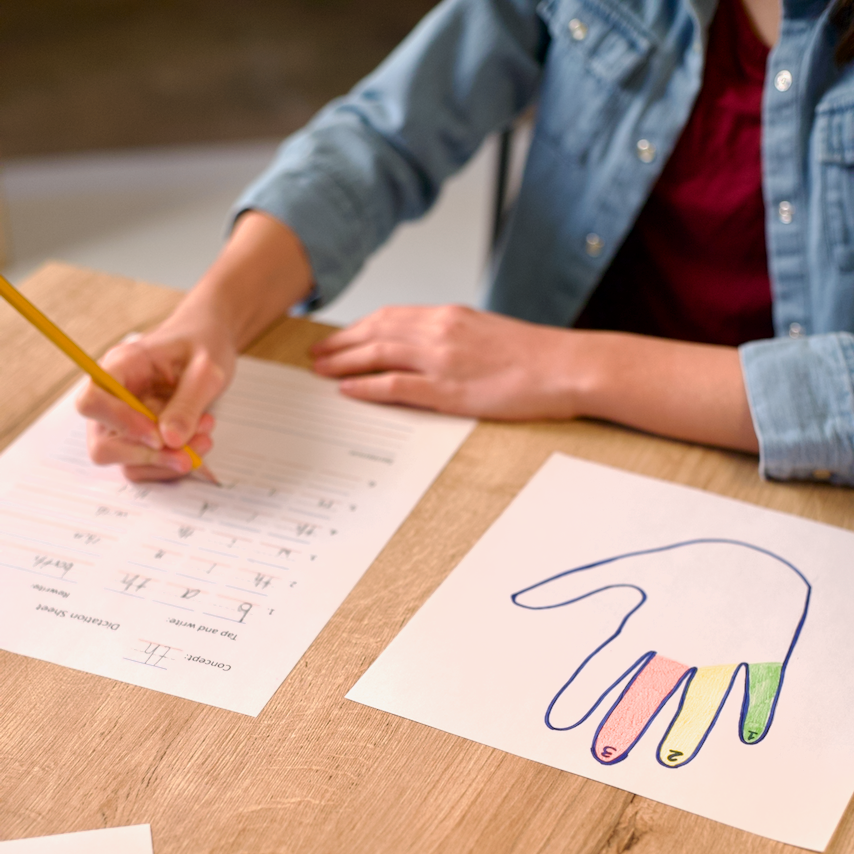
Are you ready to help your child become a confident reader?
With adaptable, science-backed techniques, a clear system to follow, and the right tools, you can make an impact that lasts a lifetime.
You don't have to be a teacher to change your child's life with literacy.
Building confident reading and spelling at home can give your child a whole new perspective on school, and on learning. Once they can access the material, nothing stands in their way.

How do you teach someone to read?
Many of us never ask this question until we are faced with helping someone who is struggling with reading, spelling, or both.
Language comes naturally to children, as does walking. One of my students equated reading with being a third skill we assume someone will eventually "pick up," like walking and talking, when that is not the case for many.
In fact, reading is not an innate human skill, meaning it must be explicitly taught.

The consequences of doing nothing
If you're a parent of a struggling reader, I probably don't have to tell you how frustrating it can be for them to feel behind, or how heartbreaking it is for you to watch them slowly fall through the cracks.
Reading and self-esteem are linked in their formative years, and the cost of waiting for reading to finally "click" can significantly impact a young person's sense of self-worth into adulthood.
Families sometimes hesitate over getting a dyslexia diagnosis due to worry over their child being labeled. My students will tell you that "lazy" and "stupid" are labels, too, and they know which label is better for their self-esteem.
They'll also tell you that there is hope. You do not need a formal diagnosis or a specialized degree to help someone overcome challenges that may seem insurmountable right now.

How to teach reading
Teaching literacy may seem unclear and intimidating, especially if you're not a teacher, or you suspect you may be dyslexic, yourself.
We can break it down into just a few parts:
• Phonetic words, which we can sound out, and which follow a set of rules;
• Non-phonetic words, which do not follow rules;
• How to build words up (encoding) and how to break them down (decoding)
That's it! There are a few more skills involved, like writing (letter formation), writing composition, reading comprehension, and vocabulary, but our task can be straightforward. It might sound like a lot, but the course is plotted and teachable with the right plan: a structured, multi-sensory plan.
...Multi-sensory?

The ace up our sleeve... or in our hand?
Humans have been using their greatest teaching tool––the body––for the last 200,000 years. Multi-sensory learning, that is learning through our five senses, teaches us not to touch fire, which food is ripe and ready to eat, and which animals to avoid (rattlesnakes give our ears their famous warning), to name but a few lessons that ensure our survival.
The truly awesome part about the brain and body's connection via thousands of nerve endings in our fingertips, plus our other four senses, is this:
We can use the body to teach things beyond survival. We can use the body to teach reading and spelling.

Reading... and spelling?
Yes, surprisingly. Who knew the teaching of one impacted the teaching of the other? I'd never thought about it until I learned how teaching structured, multi-sensory literacy could quite literally change kids' lives.
When we try to teach reading without structure or multi-sensory techniques, our best attempt can often mean encouraging students to memorize word shapes. They may correctly guess what some words say on the spot, but they can't spell them, recall them later, or successfully tackle new words on their own. Sound familiar? It's okay. You can help get them on track!
Here's the truth:
By teaching reading and spelling at the same time with multi-sensory techniques, we help them form new pathways in their brain. Now that's cool. The best part? It works.

Our mission, their future
Struggling readers do not have to struggle, and should not. Perfection is never the goal. We aren't expecting lightning-fast reading or flawless writing and spelling. We also can't expect strong literacy skills to arrive magically overnight. They are attainable with the right approach, and the right teacher: You.
Confident reading, as well as strong written and oral communication skills are a necessity in today's world. Just because someone didn't "pick it up" enough on their own to get by doesn't mean they can't learn how to access the same material as everyone else. Let's be honest: "just getting by" is not thriving, it's surviving. Without strong literacy, our children with low-literacy skills are limited by what is available to them as they become low-literacy adults, expected to survive on their own.
To me, strong literacy equals freedom. Freedom to choose their career path, and freedom to live the life of their dreams, is determined by the independence and critical thinking they gain through confident literacy.
Accessibility is at the heart of why we're here. You and your family can thrive if given the right tools, techniques, and a roadmap to follow.

Explore our tools and training
-
 Sale
SalePhonics Sound Cards
Regular price 44.95Regular priceUnit price / per89.95Sale price 44.95Sale
Frequently asked questions
FAQs
I'm not a teacher–will this be easy for me?
Yes! Our Sound Cards are designed for both parents and educators to teach and build kids' phonics skills, whether you've had OG training before or not. There are scripted teaching notes on the back of the cards, as well as easy-to-follow instructional videos in our Phonics Accelerator Course so you can work with your child with the confidence of a certified OG teacher. We promise it will be straightforward, fun, and most importantly, effective.
What age is this for?
Our tools and approach are age-flexible. Use our adaptable, multi-sensory, structured literacy materials to fill in gaps and teach advanced concepts to elementary, middle school, high school, or adult students, or teach the foundation for the first time to early learners. How does that work?
Our training and products are flexible by design, so you can adapt how you frame a lesson to be appropriate for a six-year-old, or a sixteen-year-old, depending on what they need.
Older learners who struggle with literacy still need to build the same foundational concepts as those seeing phonics for the first time.
We find that most literacy-teaching tools out there are geared for early learners and are therefore inappropriate for most intervention students. We are different because our origin is in dyslexia intervention, and most of our students are ages 9-14, or even older.
Can you tell me if my child is dyslexic?
No, only pediatricians and speech-language professionals formally diagnose dyslexia, dysgraphia, and other language-related learning differences. Our tools and training are designed to provide the most effective structured, multi-sensory approach we can offer to support learners with and without dyslexia.
A formal diagnosis can help you secure accommodations in school, but you do not need one to help your child build strong literacy. The assessment in our courses can help you define your learner's current level of mastery and give you a starting place.
Is your approach aligned with Orton-Gillingham (OG) and the Science of Reading (SOR)?
Yes! Our approach is firmly rooted in the principles of Orton-Gillingham—a structured, sequential, multisensory method that has been proven effective for learners with dyslexia and beneficial for all readers. We pair this with the evidence-based findings of the Science of Reading, which draws on decades of research in cognitive psychology, neuroscience, and education to explain how the brain learns to read.
By combining OG’s hands-on, individualized techniques with SOR’s research-backed focus on phonemic awareness, phonics, fluency, vocabulary, and comprehension, we ensure instruction is explicit, systematic, and adaptable to each learner’s needs.
How fast is shipping on physical products?
We process orders within two business days of your order. Most packages shipped domestically in the U.S. will arrive between five and ten days. We do our best to get your purchase to you as fast as possible so you can begin your work!
Can I exchange or return my purchase?
Digital downloads are non-refundable and non-exchangeable. If physical products are damaged in transit, please reach out at hello@aansenliteracy.com to initiate an exchange.
Here's to lasting, lifelong literacy
Sign up today and enjoy $10 off your first order – because every child deserves to feel confident.

